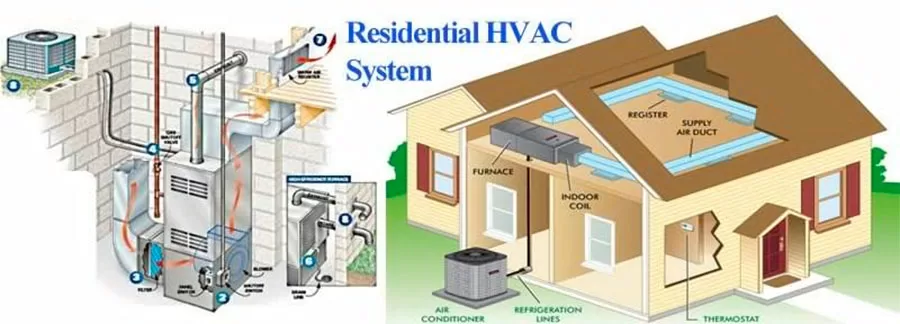Have you ever wondered how your home stays cool in the summer and warm in the winter? Your HVAC system is working hard behind the scenes, but do you know how it all works? Understanding the key parts of an HVAC system can help you maintain it better and ensure it runs efficiently.
In this guide, we’ll break down the essential HVAC system parts and explain their functions. By the end, you’ll have a solid grasp of how these parts work together to keep your home comfortable year-round.
The Furnace: The Heart of Your Heating System
The furnace is the central component of most HVAC systems. It is in charge of warming the air that moves throughout your house. Depending on your setup, the furnace usually runs on electricity, propane, or natural gas.
A furnace has several key components, including burners, a heat exchanger, and a blower. When the thermostat signals that the home needs heat, the burners ignite, and the heat exchanger warms the air. The blower then pushes this heated air through the ducts and into your living spaces.
For homes in colder climates, the furnace is an essential HVAC system part. Regular maintenance of the furnace can improve its energy efficiency, ensuring your home stays warm without driving up energy costs.
Air Conditioner: Cooling the Air
Your air conditioner is the other half of your HVAC system. It cools the air in your home when temperatures rise. Air conditioning units are usually located outside the house and work with the indoor components to keep the air cool.
The key parts of the air conditioning system include the condenser, compressor, and evaporator coils. These work together to remove heat from the air, cooling it before sending it back into your home. The evaporator coils, located inside, absorb heat from the air. Then, the refrigerant in the coils transfers this heat to the compressor, which sends it to the condenser outside to be released.
Knowing how your air conditioner works makes it easier to understand why it needs to be cleaned and serviced regularly to keep it working well. If your condenser or evaporator coils are dirty, your unit will have to work harder, which will make your energy bills go up.
Thermostat: The Control Center
The thermostat is the control center for your entire HVAC system. It monitors the temperature in your home and communicates with both the furnace and air conditioner to adjust heating or cooling.
These days, most thermostats can be programmed so that you can set different temperatures for different times of the day. You can save money with this function because it can change the temperature when you are not home or asleep. Some more advanced thermostats are even smart, which means you can use your smartphone to run the system from afar.
Ductwork: The Circulatory System
Your HVAC system relies on ductwork to circulate air throughout your home. This network of tubes delivers heated or cooled air to different rooms, ensuring even temperature distribution.
Ducts are usually made of metal or fiberglass and are installed behind walls, ceilings, or floors. Over time, ducts can become dirty, develop leaks, or become obstructed. Regular inspections and cleaning are essential for keeping your ductwork in good shape.
Leaky ducts can lead to energy loss, making your system less efficient. Ensuring your ductwork is properly sealed will help your HVAC system run smoothly and lower your energy bills.
Heat Pump: An All-in-One Solution
A heat pump is a versatile HVAC system part that can both heat and cool your home. Instead of generating heat, a heat pump transfers heat from one place to another.
In the winter, it pulls heat from the outside air and moves it inside to warm your home. In the summer, it reverses the process, pulling heat from inside and releasing it outside, functioning as an air conditioner.
Heat pumps are known for their energy efficiency because they don’t burn fuel to create heat. They work especially well in milder climates, where extreme temperatures are less common.
If you’re looking for a more eco-friendly and cost-effective option, a heat pump could be a great addition to your HVAC system. For those seeking Residential HVAC services, upgrading to a heat pump can be an excellent step towards lowering your energy consumption and improving home comfort.
Air Filters: The First Line of Defense
Air filters play a critical role in keeping your HVAC system running smoothly. They trap dust, pollen, pet dander, and other airborne particles, preventing them from circulating in your home or clogging the HVAC system.
It’s essential to replace your air filters regularly, as a clogged filter can reduce airflow, forcing your system to work harder. This not only impacts the energy efficiency of your system but also decreases indoor air quality.
Most HVAC experts recommend changing your air filter every 1-3 months, depending on how much your system is used and if you have pets or allergies.
Ventilation System: Bringing Fresh Air In
Ventilation is an essential part of maintaining indoor air quality. A well-functioning house ventilation system ensures that stale air is replaced with fresh outdoor air. This is important for removing moisture, odors, and pollutants from your home.
A ventilation system includes exhaust fans, air ducts, and vents. In some homes, a mechanical ventilation system works in tandem with the HVAC system to bring in outdoor air and exhaust stale indoor air. A good ventilation system improves comfort by maintaining proper humidity levels and ensuring clean air circulates through the house.
The Role of Energy Efficiency in HVAC Systems
Energy efficiency is a key factor in the overall performance of your HVAC system. An energy-efficient system will keep your home comfortable while using less power, which means lower energy bills and a reduced carbon footprint.
Choosing energy-efficient HVAC system parts, such as a high-efficiency heat pump or a programmable thermostat, can have a significant impact. Regular maintenance, such as cleaning evaporator coils and replacing air filters, also plays a big role in keeping your system running efficiently.
The Importance of Understanding HVAC System Parts
Knowing the basic names of HVAC system parts and what they do can help you take better care of your system, save money on energy costs, and keep your home warm all year. Each part of your HVAC system is very important to its general performance, whether it is cleaning the air filters, upgrading your heat pump, or making sure there is enough air flow.
Did you like this guide? Great! Browse our website for more!
Stay in touch to get more news & updates on Buzz Slash!




